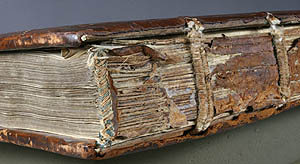The ‘Selden Map of China’ arrived at the Bodleian Library in 1659 as part of John Selden’s bequest. It was long considered a rare curiosity until 2008, when an American scholar, Robert Batchelor of Georgia Southern University, noted that it records coastal trading routes linking the port of Quanzhou in Fujian Province with other parts of South East Asia. The map is now recognised not only as a beautiful and colourful representation of China and South East Asia, but also as a unique historical record of China’s trading activities in the early 17th century.
Through this renewed interest, the map’s fragile condition was highlighted, initiating a detailed technical examination and major collaborative conservation and research project. The map’s vulnerable condition was already noted in conservation records from 1977, being described as “crudely mounted on paper and linen in 1919 as a hanging scroll, though not originally intended as such. The linen has stiffened, and is severely cracked in many places.”
At the time no treatment was attempted, but now circumstances allow this challenging conservation project to go ahead with the combined expertise of conservators Robert Minte and Marinita Stiglitz (Bodleian Library) Keisuke Sugiyama (British Museum) and Mark Barnard (British Library).
The extensive treatment of the 1m. x 1.5m map, using Western and Far Eastern techniques and materials, aims to stabilize the map’s paint layer and strengthen its thin Chinese paper support.
During the first stage, the map was gradually humidified by spraying purified water onto the surface from both sides using dahlia sprayers. This drew out discolouration, flattened distortions, and enabled the textile lining to be removed.
Next a temporary facing, consisting of several layers of rayon and sammoa paper, was applied on the front with funori, adhesive extracted from Japanese red seaweed, using noribake, Japanese paste brushes. The map was left to dry flat on a karibari, Japanese drying board, for a few days…
The facing protects the fragile surface whilst paper patches and adhesive layers are removed from the back. Loose fragments will be secured, missing areas infilled and new paper linings applied, restoring the map’s original flexibility and appearance.
This project will continue until next spring. Funding for the conservation work has been generously provided by The Pilgrim Trust, The Radcliffe Trust, Sir Robert Horton, The Mercers’ Company and Merton College.
History & image of the Selden Map.
For more information about John Selden’s collections, visit the Bodleian Library website.














